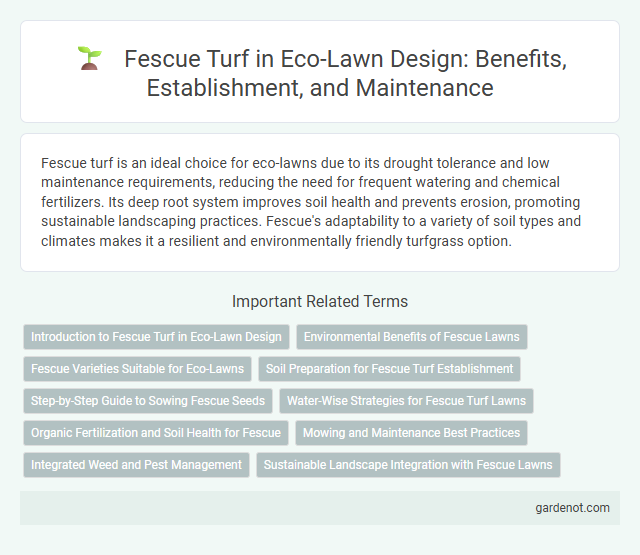Fescue turf is an ideal choice for eco-lawns due to its drought tolerance and low maintenance requirements, reducing the need for frequent watering and chemical fertilizers. Its deep root system improves soil health and prevents erosion, promoting sustainable landscaping practices. Fescue's adaptability to a variety of soil types and climates makes it a resilient and environmentally friendly turfgrass option.
Introduction to Fescue Turf in Eco-Lawn Design
Fescue turf is a resilient, shade-tolerant grass variety ideal for eco-lawn designs due to its low water and nutrient requirements. Its deep root system enhances soil stability and promotes natural weed suppression, making it an environmentally sustainable choice for residential and commercial landscapes. Incorporating fescue turf into eco-lawns supports biodiversity while reducing maintenance efforts and resource consumption.
Environmental Benefits of Fescue Lawns
Fescue turf enhances soil health by reducing erosion and promoting water infiltration, conserving vital resources. Its deep root system increases carbon sequestration, contributing to lower greenhouse gas levels. Drought tolerance in fescue lawns reduces irrigation needs, minimizing water consumption and supporting sustainable landscapes.
Fescue Varieties Suitable for Eco-Lawns
Fescue turf varieties such as Fine Fescue species--Creeping Red Fescue, Chewings Fescue, and Hard Fescue--are highly suitable for eco-lawns due to their low water requirements and shade tolerance. These Fescues promote biodiversity by supporting native pollinators and require minimal mowing and fertilization. Their deep root systems improve soil health and enhance drought resistance, making them ideal for sustainable landscaping.
Soil Preparation for Fescue Turf Establishment
Proper soil preparation for Fescue turf establishment involves testing soil pH to maintain a range between 5.5 and 7.0, ensuring optimal nutrient availability. Incorporating organic matter like compost improves soil structure, drainage, and moisture retention essential for healthy Fescue root development. Aerating compacted soil and removing debris creates an ideal seedbed, promoting uniform germination and robust turf growth.
Step-by-Step Guide to Sowing Fescue Seeds
Prepare the soil by loosening it to a depth of 4-6 inches and removing debris to ensure optimal seed-to-soil contact for Fescue turf. Evenly distribute the Fescue seeds at a rate of 6-8 pounds per 1,000 square feet, then lightly rake the surface to cover the seeds with a thin layer of soil. Water the area consistently, maintaining moisture until germination, which typically occurs within 7-14 days under ideal conditions.
Water-Wise Strategies for Fescue Turf Lawns
Fescue turf, known for its deep root system, thrives with water-wise strategies that include infrequent, deep irrigation to promote drought resilience. Maintaining soil moisture at around 50-70% allows Fescue to withstand dry periods while reducing water consumption by up to 30%. Incorporating organic mulch and aerating soil enhances water retention and supports sustainable lawn health in eco-lawn practices.
Organic Fertilization and Soil Health for Fescue
Fescue turf thrives with organic fertilization, which enhances soil microbiome activity and improves nutrient availability, leading to stronger root development and drought resistance. Incorporating compost and natural amendments supports soil structure and promotes ecological balance, reducing the need for synthetic chemicals. Consistent organic fertilization helps maintain sustainable soil health, ensuring resilient and lush Fescue growth over time.
Mowing and Maintenance Best Practices
Fescue turf thrives with mowing heights maintained between 2.5 to 3.5 inches, promoting healthy root development and drought resistance. Regular mowing intervals of 7 to 10 days prevent stress and encourage dense growth, reducing weed invasion. Proper maintenance includes avoiding cutting more than one-third of the leaf blade at a time and ensuring mower blades are sharp to minimize turf damage.
Integrated Weed and Pest Management
Fescue turf thrives with Integrated Weed and Pest Management (IWPM), combining targeted biological controls and selective herbicides to minimize chemical usage while promoting healthy growth. Implementing IWPM enhances fescue's resistance to common pests like grubs and broadleaf weeds, reducing environmental impact and maintenance costs. Regular monitoring and tailored treatments ensure sustainable turf health and biodiversity in eco-lawn ecosystems.
Sustainable Landscape Integration with Fescue Lawns
Fescue turf offers exceptional drought tolerance and low maintenance requirements, making it ideal for sustainable landscape integration. Its deep root system enhances soil health by improving water retention and preventing erosion in eco-lawn settings. Choosing Fescue lawns contributes to reduced irrigation needs, promoting environmental conservation and eco-friendly gardening practices.
Fescue turf Infographic

 gardenot.com
gardenot.com